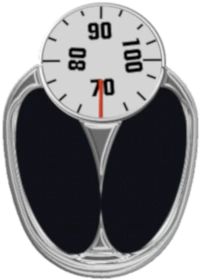WHtR Calculator
Waist to Height Ratio Calculator
Calculate your Waist to Height Ratio – WHtR
 The Body Mass Index (BMI) has certain weaknesses because it ignores stature and body fat distribution. Recent research has shown that the Waist to Height Ratio (WHtR) is significantly more accurate than the BMI in determining whether someone is overweight or not.
The Body Mass Index (BMI) has certain weaknesses because it ignores stature and body fat distribution. Recent research has shown that the Waist to Height Ratio (WHtR) is significantly more accurate than the BMI in determining whether someone is overweight or not.
The WHtR takes into account that belly fat, in contrast to other fat deposits, has a negative effect on your health. Belly fat is always associated with fatty degeneration of internal organs. This is a risk for arteriosclerosis, cardiovascular disease and diabetes. For this reason, the abdominal circumference is a strong indicator of overall health risk. Even if your BMI is in the normal range, you may be at significant health risk if your WHtR is increased.
In principle, the ratio of waist to height (i.e. WHtR) should be between 0.40 and 0.50 for adults.
If possible, you should avoid a WHtR value greater than 0.53. A WHtR of 0.53 corresponds approximately to a BMI of 25.
The right way to measure your waist size (belly circumference)
A basic tailor's tape measure is the ideal tool for measuring your waist and belly circumference. Measure your waist size in the morning right after getting up and before breakfast. It is best to do this standing up, directly on your skin. Breathe out normally just before the measurement and don't suck in your stomach. By pulling in your belly you would get a wrong value.
Measure the waist circumference:
The waist or belly circumference is measured at the widest part of the belly. This point is usually one to two centimeters above the belly button.
Enter the measured values for your height and waist circumference in centimeters as well as your age in the form and click Calculate button.
WHtR Classification
The same WHtR values apply for women and men.
Due to various factors, most people's stature change as they get older. This is natural and not unhealthy. Compared to younger people, older people tend to have less muscle mass and a higher amount of body fat.
The WHtR table takes this natural change into account when classifying normal weight and overweight. Between the ages of 40 and 50, many people experience a change in body size. After the age of 50, a stable body weight should return.
| Classification | under 15 years | 15 - 39 years | 40 - 49 years | from 50 years |
|---|---|---|---|---|
| Underweight | below 0.34 | below 0.40 | below 0.40 | below 0.40 |
| Normal weight | 0.34 – 0.45 | 0.40 – 0.50 | 0.40 – 0.59 | 0.40 – 0.60 |
| Overweight | 0.46 – 0.51 | 0.51 – 0.56 | 0.60 – 0.66 | 0.61 – 0.66 |
| Obesity | 0.52 – 0.63 | 0.57 – 0.68 | 0.67 – 0.78 | 0.67 – 0.78 |
| Heavy obesity | above 0.63 | above 0.68 | above 0.78 | above 0.78 |
The WHtR is based on waist size. This means that the percentage of abdominal fat is taken into account. Unlike the WHtR, the calculation of BMI doesn't include body fat distribution and muscle mass. This is the reason why muscular people, such as athletes, fall into the category of overweight or even obesity in the BMI classification. This misclassification doesn't exist with the WHtR because it uses abdominal circumference in the calculation.